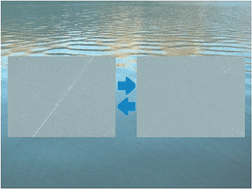Stabilization of catechol–boronic ester bonds for underwater self-healing and recycling of lipophilic bulk polymer in wider pH range†
Abstract
To develop a lipophilic bulk polymer capable of self-healing and recycling for future structural applications in different aquatic environments, hyperbranched polyurethane containing a few hydrophilic quaternary ammonium salts and abundant dynamic reversible catechol–B3+ crosslinkages is synthesized as our first step in this direction. The compositional and structural design ensures dynamicity of the polymer networks as well as effective interdiffusion and interaction of dangling chains on the damaged surface in water. More importantly, the boronic ester bonds become not easily hydrolyzed at lower pH due to the electron attracting effect of quaternary ammonium cations from catechol–B3+ bonds. Qualitative visual inspection and quantitative tensile tests demonstrate that the proposed idea works, and the target polymer is allowed to be self-healed and reprocessed in waters at pH 7 and 9 at room temperature. Reshuffling and rearrangement of the polymer networks via dynamic reversible coordination of catechol–B3+ bonds helps to re-bond the interface. The technical route provides an effective solution to stabilizing catechol–B3+ bonds at lower pH, and obviously reduces the pH sensitivity of boronic ester bonds, which is the objective of the current work. As a result, the adaptivity and serviceable range of the underwater intrinsic self-healing polymer are expanded.


 Please wait while we load your content...
Please wait while we load your content...